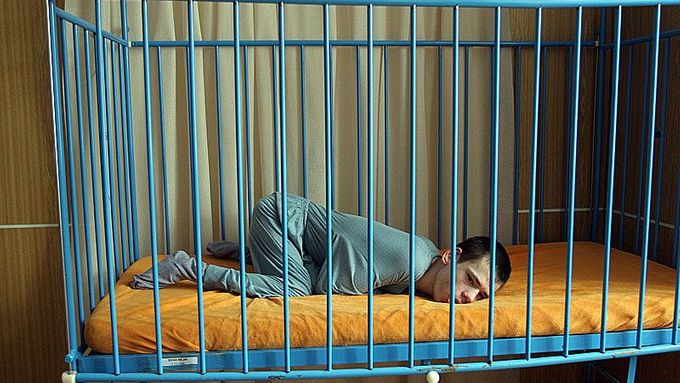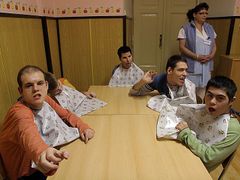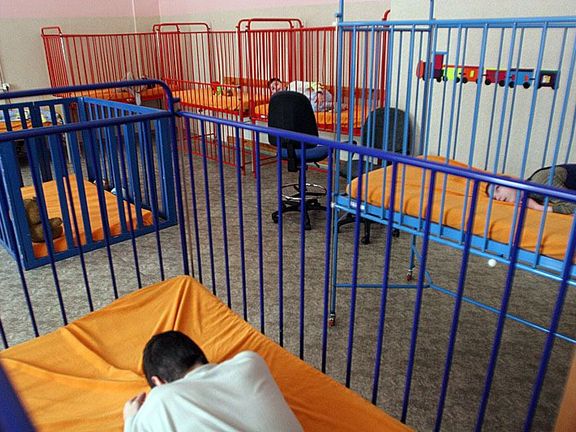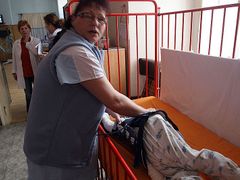Liběšice - It's almost midday. Most of the 140 clients in Liběšice's children's care home are waiting for their lunch. Eighteen of them are waiting, lying locked in beds with bars around them.
Reporters from Aktuálně.cz visited Wednesday the children's care home where the BBC used the undercover camera to record children being held in cage beds.
A 2007 law bans the use of beds surounded by bars or nets. Nevertheless, some social care homes, including that of Liběšice, found a way around. They are locking their clients up in something they call babies´ cots.
The principle remains the same, though, the bars around the bed reach so high that the clients cannot get out.
Some of the employees even used orthopaedic devices to immobilize them in front of the Aktuálně.cz reporters.
Behind the bars
Those with the most severe disabilities live on the first floor of the old castle where the care home is located.
But there are two rooms that are different: cage beds, one next to another, line the walls. Children as young as 7 years are kept in them, but also some adults around 20. Only one reason is being quoted: the users could fall down, meaning more work for the staff.
"These cots are offered in the market anyway. We had them ourselves at home too," the chief nurse Blažena Pešková says. "It's for their own good, since they could fall off a normal bed. The bars are to protect them from falling."
No doctor made the decision to lock up 18 people in the Liběšice care home into a 1 by 2 metres space with the bars. But for the employees, it is common practice.
"There is no need for somebody to decide. As long as it prevents injury, this restriction measure does not need to be approved," Mrs Pešková claims. "It's better for them to be locked up than to harm themselves. They are unable to move anyway, so we are not restricting them at all. Without these devices, the personnel would have to keep watching them."
"No need to change"
While the chief nurse is trying to explain the advantages of the "babies´ cots", another nurse is using a rather odd looking device to fix one of the clients' arms to his body. Some of the caged children have orthopaedic devices on both arms.
That does not come as a surprise to the chief nurse. "We are using them with about ten of the clients," she said. "That's to prevent them from harming themselves. The one with the orthopaedic devices on his arms was always putting his hand in his mouth to puke, and the device will prevent him from reaching his own face."
So far, nobody has criticized the Liběšice care home for the practice. "People from the regional office came up to check and they had no qualms about them," the chief nurse says. "So we don't feel any need to change it. I think it's not bad here."
"No bad feelings"
This same children´s care home was one of the eight visited earlier by British journalists who used the undercover camera to record children in cages.
"They were pretending to be Dutch and to want to offer us money," another chief nurse, Mrs Pražáková says. "They kept asking where the beds were, but would not say directly what they wanted to see."
The care home only found about the secret filming today. "I have no bad feelings, we are not flouting the law," is Mrs Pražáková's response. "I'm only sorry that we are trying to do our best with the clients, and nobody would tell us anything went wrong."
A cot or a cage?
Eva Pogodová, the director of the Association of the guides for handling high risk behaviour, says that it is obvious people should not be handled in this way.
"This is absolutely unacceptable," Pogodová who trains staff how to work with children's care homes' clients without restraining devices, explains. "If the clients have no option to leave freely, and if moreover they are immobilised, it is qualified as an absolutely illegal restriction."
No children or anybody over three years of age should be confined to cage beds or cots under the law. In Liběšice, children from 7 years upwards are living in the barred world.
"Cheap tricks of BBC"
The Labour and Social Affairs Minister Petr Nečas does not agree. "It's normal, my children were living in a cot with bars until they were three years old," he told Aktuálně.cz. "It does not matter whether a client is twenty, their mental age makes the difference."
He also said the BBC report was manipulated. "This is a classical journalistic distortion," Mr Nečas said. "I am concerned about the whole issue, it worries me, but I refuse to fall for the BBC's cheap and stupid tricks."
According to Mr. Nečas, the use of the "cots" where the clients spend the whole day is completely legal. "It's completely normal to use them if the doctor and the person's guardian agree," he says. "I am not sure whether they keep to this rule in Liběšice, and should there be suspicion of the violation of the clients' rights, this would have to be looked into."
The Ministry therefore will send an inspection team to the social care homes that were mentioned in the BBC report.















